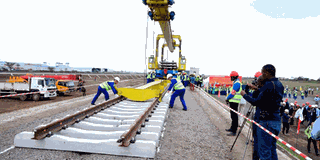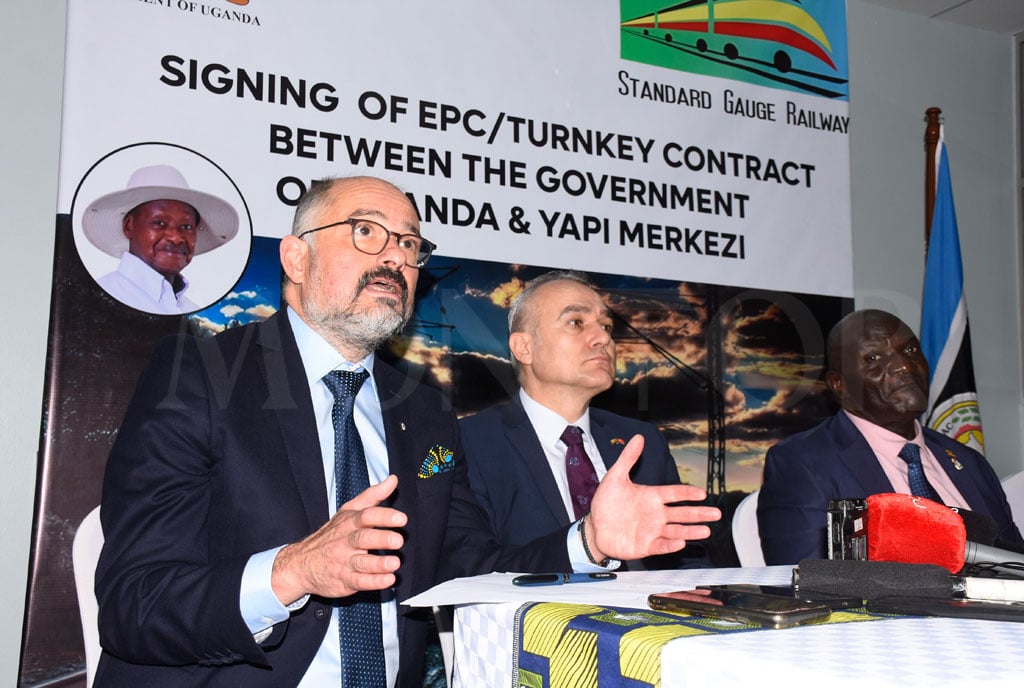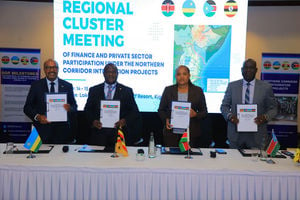
Workers lay tracks for the SGR Phase 2A in Narok, Kenya, on August 1, 2018. The Construction of the SGR from the eastern border of Malaba to Kampala is set to start before the end of the year. PHOTO/NMG
In the world of transport, being fashionably late is rarely an advantage.
That is where Uganda finds itself in the Standard Gauge Railway (SGR) regional race where progress has surged ahead in its absence.
With a fresh deal signed to begin construction, the country can now sigh.
But can it truly catch up with its neighbours, who are already reaping the rewards of their rail investments or watch the train of opportunity roll by?
On October 14, Uganda took a bold leap forward by signing a landmark deal with Turkish construction giant Yapi Merkezi to build the first 272-kilometre section of a planned 1,700-kilometre electric rail line.
After intense negotiations, the project cost was set at €2.7 billion (about Shs10.8 trillion). This ambitious project will connect the Malaba border with Kenya to Kampala, something good for the regional transport.
Shortly afterward, the project coordinator Perez Wamburu declared that construction would begin in November and be completed in four years, accounting for complex structures such as a dual-purpose bridge over the Nile.
This bridge will accommodate both the SGR and vehicle traffic, eliminating the need for a separate bridge as the country develops the expressway.
According to official documents from the Transport and Infrastructure Ministry, this design aims at maximising functionality while minimising additional construction costs.
Under the Engineering, Procurement, and Construction (EPC) model, Yapi Merkezi will manage the engineering, procurement, and consortium management aspects of the work, as well as provide all necessary components, including rolling stock like engines, coaches, and wagons.
It will also implement a management system, delivering a complete product to Uganda when the project is completed. General Katumba Wamala, Uganda’s Transport and Works Minister confirmed last week that these aspects were part of the negotiations that have been underway for the past year to ensure optimal value for money.
Benefits
Initially, Yapi’s quote stood at €3.4 billion. However, after more than two months of negotiations, Uganda successfully reduced this amount by €700 million, bringing the final figure to €2.7 billion.
Notably, Yapi Merkezi assumes all risks associated with this price, which remains fixed despite any fluctuations in material costs and this, Prosper Magazine understands, is the reason why the contract amount has surged from what the Chinese had initially quoted at €2.2 billion eight years back.
This project is crucial for Uganda as it seeks to access the sea, much like Ethiopia's efforts to enhance its trade with the global market at minimal costs. Alternatives such as air freight are relatively expensive, and water transport, which connects to road transport at ports, also incurs high costs.
One significant advantage of the SGR to Uganda is its potential to halve the transportation costs from the Mombasa port to Kampala, as many transport economists point out.
Currently, transporting a single container costs about $3,500 (Shs12.8 million), but this figure is expected to decrease, positively impacting consumer prices and fostering regional connectivity in the East African region.
In terms of influence, this benefits Turkey, particularly as China begins to scale back on major infrastructure projects, creating opportunities for new players in the market.
Turkey has already successfully constructed a $3.1 billion SGR in Tanzania, and achieving similar success in Uganda will enhance its presence on the African continent.
How it started
Uganda's SGR project has been in the works since 2014, originating from an initial concept by President Museveni. He proposed it to President Mwai Kibaki, who in turn presented it to the leaders of Rwanda and South Sudan as part of a northern corridor infrastructure initiative.
Mombasa serves as Uganda's main port along this corridor, with the SGR designed to connect it to the interior of Uganda, facilitating distribution channels and spurs to Rwanda and South Sudan.
Given that Kenya was the entry point from the sea, construction began at the Mombasa port, necessitating significant upgrades there to handle cargo within the northern corridor.
But while the project advanced to Naivasha, it stalled. This was a blow to Uganda but instead of waiting, it began negotiations with the China Harbour Engineering Company (CHEC) to build the nation's first phase of the SGR.
The plan includes several key railway lines: the northern line from Tororo to Gulu and on to Nimule at the South Sudan border, covering 465 km, with a spur from Gulu to Pakwach and then to Vurra at the Democratic Republic of Congo, spanning 297 km.
The western line runs from Kampala to Bihanga, then to Kasese and Mpondwe, also reaching the DRC border with a spur to Hima Cement, totaling 383 km. Lastly, the southern line extends from Bihanga to Mirama Hills via the Rwandan border, with a spur to Muko, measuring 280 km.
To have this progress, Uganda engaged in extensive negotiations with the Exim Bank of China, but the bank grew uncertain about the project's viability.
Concerns arose regarding Kenya's SGR project halt at Naivasha, a situation that complicated the guarantee of return on investment. Eventually, Uganda terminated the deal with CHEC early last year.
Interestingly, a year before that, Tanzania had began its SGR project with the same company that Uganda has now contracted, a deal that General Katumba believes was brokered by President Museveni.
The Transport Ministry anticipates that the SGR will deliver Uganda globally competitive transport services for both freight and passengers. The project is expected to create over 150,000 jobs—both directly and indirectly—during construction, reduce production costs by 30 percent, and enhance Uganda’s competitiveness through a more reliable transport system.
Financing
However, the question remains: Where will the funding come from?
Currently, the Finance Ministry is negotiating a funding mechanism and has already given the Transport Ministry assurance. The National Treasury already allocated some Shs2.2 trillion in the running national budget to the project.
Additionally, General Katumba says institutions such as Citibank and the African Development Bank are prepared to finance the project, the specifics of each contributor have yet to be disclosed.
Uganda is also looking at other development and export credit agencies, focusing on syndicated loans with Citi Bank as the lead arranger.
The country is only hoping that it does not get a déjà vu. The Chinese investors withdrew due to uncertainties about Kenya's ability to complete the SGR to the Malaba border concurrently with Uganda's project. As a result, talks stalled, leading to the contract being awarded to the Turkish firm.

A cargo train at the Naivasha Inland Container Depot in Kenya. Currently, goods destined for Uganda from Mombasa port are transported by road from Naivasha where the multi-billion shilling SGR line from Mombasa ends. PHOTO | FILE | NMG
Meanwhile, Uganda is rehabilitating the meter-gauge railway between Malaba and Kampala.
Both the SGR and the meter-gauge railway can coexist, but they will not share the same tracks. The meter-gauge railway is designed to transport heavy cargo, such as steel and other goods that do not require fast delivery, while the SGR will focus on moving well-packed container cargo efficiently.
Suppliers
Ugandan suppliers have reason to smile. General Katumba confirmed just after signing Yapi’s contract that 40 percent of the construction supplies will be sourced from local companies.
This comes as a response to concerns raised by organisations like the Uganda National Association of Private Educational Institutions, which criticised the government for awarding major projects to foreign firms at the expense of local businesses. Ugandan officials are well aware of this issue.
General Katumba said the state emphasized to Yapi that “it should not import things like cement, iron bars, and many technical people”— because these are the same things that the country has successfully tested in projects such as the Jinja Bridge and the Flyover.
While there has been past criticism about the quality of Ugandan companies in engineering and construction, Transport Ministry officials now acknowledge their recent improvements. This has led to local firms being awarded contracts for projects such as the Busunju-Kiboga-Hoima road and the rehabilitation of the Matugga-Katuuka road.
However, General Katumba pointed out that “there are challenges where Ugandan companies are concerned,” specifically noting organisational capacity: “Sometimes you find the company’s proprietor is the manager, the financial officer, the engineer, and everything.”
He also cited financial limitations, adding that “financially, they cannot match international companies.”
In response to these issues, President Museveni last month instructed Finance Minister Matia Kasaija to remove the requirement for local contractors to provide bid bonds when bidding for government contracts.
Bid bonds, which act as financial guarantees to ensure compensation if a contractor fails to start a project, have been a concern for local contractors, who often need to stake their properties to secure such guarantees because it was deemed costly and burdensome.
Instead, he proposed that the government should assess a contractor’s ability to complete the work: “If a contractor fails to perform, they should not be paid, and their contract should be terminated” without the need for costly guarantees.
This directive is intended to empower indigenous companies and enable them to compete more effectively against foreign firms, which often dominate domestic projects due to their access to better financial resources and guarantees.
Right of way
For the project to progress, the government must relocate people residing on the affected land by offering compensation packages.
According to Mr Wamburu, the secretariat has secured 150 kilometers of the 272-kilometre Right of Way between Malaba and Mayuge, which accounts for approximately 54 percent of the entire path from Malaba to Kampala.
While more than half of this route has been settled, the challenge arises as the government begins compensating residents in Jinja and moves towards Kampala. These areas are densely populated and contain valuable land, which could significantly increase compensation costs.
EAC plan
The Malaba-Kampala project is a critical part of the East African Community Railway Masterplan, aimed at revitalising the Northern Corridor through the Northern Corridor Integrated Projects Railway Network, which will link Uganda to the Port of Mombasa via Nairobi.
“As Uganda, we are aware that for member countries to reap the most benefits from seamless SGR connectivity, the construction of the Naivasha-Kisumu-Malaba to Kampala SGR sections must be fast-tracked and ensure interconnectivity at the earliest possible time,” said General Katumba.
He noted that these timelines have been discussed with Uganda's partners, the government of Kenya.
In August, Tanzania officially launched passenger services on its new electric SGR, connecting the port city of Dar-es-Salaam to its capital, Dodoma.
Meanwhile, Kenya is in discussions with Beijing to fund the Naivasha-Malaba section.
The country has already assumed 90 percent of the operations of the SGR from Africa Star Railway Operation Company, with a full takeover expected by June 2025.
This move is part of a broader strategy to reduce soaring operational costs.
Kenya’s Transport Principal Secretary, Mohammed Daghar, revealed that Kenya is also seeking investments from Chinese and Turkish financiers for the Naivasha-Malaba link, which is estimated to cost $5.3 billion. The project has been stalled for over five years.



